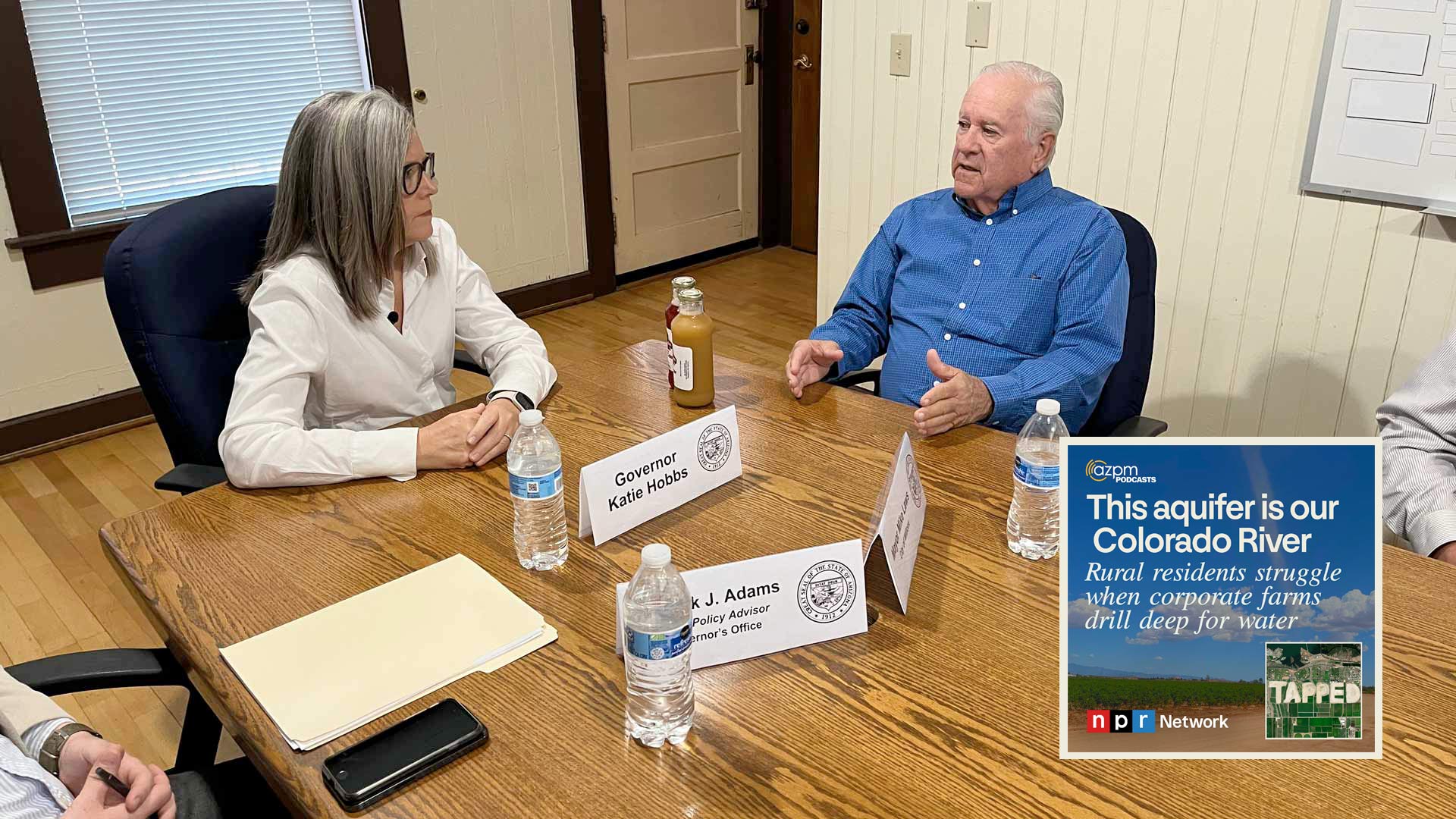 Governor Katie Hobbs discusses water issues with Willcox Mayor Mike Laws. September 5, 2024.
Governor Katie Hobbs discusses water issues with Willcox Mayor Mike Laws. September 5, 2024.
Tapped: Season 3 Episode 08.5

[Music fade in]
Zac Ziegler: Hi, I’m Zac Ziegler… host and producer of Tapped. This season of Tapped has had a couple of new features for us: we’ve had Gen Z Insta posts, episodes with cliffhangers, we’ve broken our own records for downloads, and, for a very short while, we've been the number one trending podcast in the world. We’ve also broken news about hedge funds and foreign wells. Now, we have another first for us… a bonus episode.
[ Music Fade out]
Christopher Conover: I’m Christopher Conover. Three episodes ago we took you along for our summer road trip to La Paz County Arizona and brought you the history and the concerns related to Arizona’s agricultural ties to Saudi Arabia—and Fondomonte—the Saudi company growing and exporting alfalfa on tens of thousands of acres. Since we aired that story, Zac was tipped, confirmed with some digging, and broke the story that the farm had filed the necessary paperwork to sink more wells…straws into the aquifer, if you will, to more than 1,500 feet.
ZZ: That reporting on our home station, AZPM, and my appearance on our sister station KJZZ, caught lots of attention… including that of Arizona Attorney General Kris Mayes, who sent an angry, 3-page letter to the state Department of Water Resources demanding that they revisit that well application.
CC: Mayes agreed, shortly after she sent the letter to sit down with us and talk about the issue.
Arizona Attorney General Kris Mayes: I held a town hall in Wenden that was attended by, I think, more than 200 people who are sick and tired of the state allowing this kind of damage to happen to them. It's just not acceptable anymore. And I think that the governor and ADWR had multiple ways that they could have addressed this and that they should address this in terms of not approving that additional well. I mean, there already have been dozens of wells approved in this area for this one entity, and this is not an area that that needs to be further harmed. We need to push the pause button and at a minimum, DWR needs to study this area.
ZZ: The day that we got the new wells for Fondomonte story confirmed, Chris was on the road in Cochise County with Governor Katie Hobbs to look at water issues. So he got a chance to ask her about what she thought about big corporate farms sinking wells and potentially endangering the aquifers that are relied on by local homeowners, cities, and farmers.
Governor Katie Hobbs: We would need legislation to change that. There's not an executive tool that we have, so we're continuing to look at all of the options
ZZ: We'll hear more from the governor coming up, but Mayes doesn't see the need to wait on state lawmakers. She has investigators from her office looking at the issue. And not only in La Paz County, but in Cochise County in southeastern Arizona also.
KM: First and foremost, I think the companies that are involved in creating this damage should be held accountable, and that's something that that we're looking at in my office, in terms of examining whether the state's nuisance laws were violated by the Saudis and by Riverview. There's a reason that I have sent investigators out to both of these areas, and so I think ultimately these companies should make residents whole for the damage that they caused to the residents and to the county. I mean, we're talking about the situation in both these areas, and in particular in La Paz County, in which Saudi Arabia drained their own aquifers by growing alfalfa over just a few decades, then they made it illegal in in Saudi Arabia to do this, and then hopped across the ocean to the United States into a place called Arizona that it realized was foolishly allowing this to happen. We need to stop playing the fool and put a stop to these practices and protect the people of Arizona and not have these lax groundwater laws and also at least enforce the laws that we have on the books right now.
ZZ: As we, and the Attorney General said, aquifer problems are not unique to La Paz County in western Arizona. After the break, we will let you be a fly on the wall for Chris’s trip to Cochise County in Eastern Arizona with the governor to hear about water problems there.
[NPR Promo]
ZZ: This is Tapped a podcast about water, I’m Zac Ziegler.
CC: And I’m Christopher Conover.
ZZ: Before the break we heard from Arizona Governor Katie Hobbs about big corporate farms drilling more wells. She made those comments during a day-long listening tour in Cochise County…on the other side of the state from where Fondomonte has its wells. Christopher Conover was along for that trip, so I will turn things over to him.
CC: Even though we were in eastern Arizona…many of the issues we heard about that day were the same as what we heard in the part of western Arizona we've been reporting on. Both areas rely, not on the Colorado River for water but underground aquifers.
[Nats of greetings…etc]
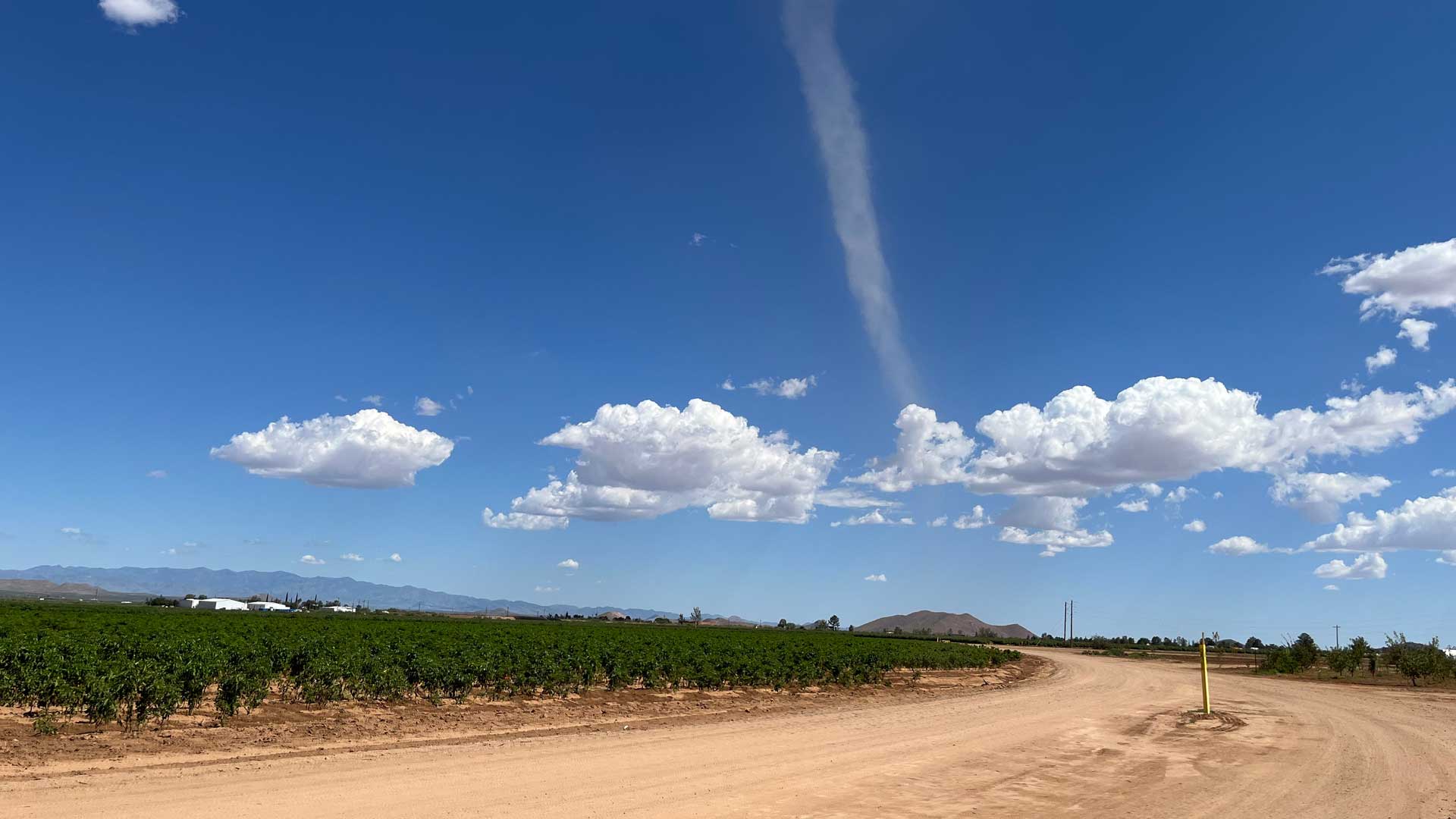 A farm in Cochise County, AZ
A farm in Cochise County, AZ
CC: Hobbs started her day in Willcox meeting with the city’s mayor, vice mayor, and city manager to get their perspectives on water issues in the city of about 32 hundred people.
City Manager Caleb Blaschke began by explaining a little bit about the area…
Caleb Blaschke: We're an agriculture community, we have lots in the wine industry. I want to thank you for that as well. Through AOT, we've been able to get almost half a million dollars in grants, and so we've improved signage, but the wine industry has really revitalized Wilcox, and it's been huge for us.
CC: When we and others talk about wells in rural Arizona…we often speak about private wells for homes or farms…not municipal wells. But in Willcox that is the problem…
CB: Recently, we had an issue with our own city well. Our well resides about four miles outside of the city limits. We call it W Mountain. It's at the top there, and so we transport water through one line, four miles into our city, and right along that we have three wells that are located there. They're pretty close, but it was the best source of water that was the purest and cleanest and so that's where the water was put. Recently we had a neighbor that put in a water hauling station there, and it decreased our water usage quite a bit, and caused some major issues with our well. And that took a lot of trying to get everyone to work together very quickly, but to try to solve that issue there. So this is the area where our well is located at, and as you can see, there's pivots on the left side. There's actually more pivots above, and where the water, bulk water hauling station was put in, right across from it there, there's empty land, and the rumor is that that could soon be a pivot. So now our city wells will be surrounded by pivots. And this is something, again, that concerns us, because there's no legislation in place to protect it
CC: And people throughout Cochise County are having the same problem that the city is…and that does impact the city according to Caleb…
CB: The county seat is almost an hour and 15 minutes away. So everyone really relies on us to provide their shopping needs, park needs, little league sporting groups. They come to Wilcox.
CC: And Willcox is there to help according to the city manager and Mayor Mike Laws…
CB: We put in a bulk water hauling station to service county residents as well within the city, so people whose wells have gone dry can now haul but we see an increase in usership of that.
Mayor Laws: Yeah, when their wells go dry, they don't have the money, yeah, you know, and so they're, they're just sitting out there alone. So we did that, and they come in, and we do a lot of that kind of stuff.
CC: He tried to put water use in the area in perspective for the governor by pointing out how much water the city…a municipal water supplier uses…versus a large corporate dairy farm in the area…
Laws: We use about 425,000 gallons a day for an entire city, right? Which we think there's 4000 people here. Just the dairy itself is pumping 300 million a day.
CC: The stress on the small Willcox municipal water system came to a head recently when a technical issue shut the city wells down on Friday afternoon. Vice Mayor Greg Hancock told the Governor that really hit home for him…a sentiment echoed by the city manager and the mayor…
Greg Hancock: We really appreciate your concern about our rural Arizona water down here, I own a mom-and-pop hotel, and what was about a month ago, he called me and said, Hey, our wells are down, you know. And so me, being the pop, I was kind of nervous gonna have to call all my people staying tonight, you know, tell them, Hey, can't stay here. We don't have water.
Caleb: We actually had some businesses when we made the announcement that we're conserving water because of the well-being down. All we were relying on was our tank. They actually closed their business just to be supportive of the community for the decay. So I mean, that was huge for them to do that.
Gov. Hobbs: And the dairy farmers aren't doing that?
Laws: No. They're all on automatic. They just it can be poured down, raining out there, and they're still pumping.
CC: Not all of the talk between the elected officials was complaints about the problems…there were also suggestions. The mayor spent years in the well pump business and said he knows lots of farmers and he said the local farmers know the solution…or at least part of the solution…to the water problem…
Laws: It's just common sense. You just have to lay some land out. It's just what happens. They claim are taking out five times the water, then it goes in.
CC: The Mayor accused the big corporate farms of not only being unwilling to as he said layout or leave some fields fallow so they use less water but also purposely wasting water…and he challenged the governor
Laws: And if you could do something, Governor like, I'm just thinking out of the box, but those kind of people, they're not even farming, they're pumping it out on the ground, right to keep the water. If you can say, Hey, stop. You're not going to lose your water. You're not going to lose your water. I'm just saying that's what I would do. I would just say, look, I want you to stop because you're not using it anyway. You're just pumping out. We found that others just pumping on the ground. So, they get their allocation. So, if they sell their property, they have the water, but they need to pump it to keep it. That makes no sense.
Gov. Hobbs: Yep.
Laws: If you could do something to just say, Hey, okay, from now on, you can turn your wells off. You're safe.
But the mayor made it clear… the state must step in…
Laws: It's really putting a lot of the monkey on your back that I believe that you're going to have to do something to lay out just make them do what they used to do, and they never had that many issues. We've had a water problem forever, yeah, 50 years.
Gov. Hobbs: And I, you know, when I came into this role, I knew that kick the candy on the road, on this for a long time, and so happy to have the monkey in my back. We're gonna do something about it.
CC: Governor Hobbs' trip to Cochise County did not end with meeting local elected officials. Our next stop was miles south to meet Arizona Department of Water Resources Principal Hydrogeologist Brian Conway to talk about earth fissures and how they are tied wells going dry…
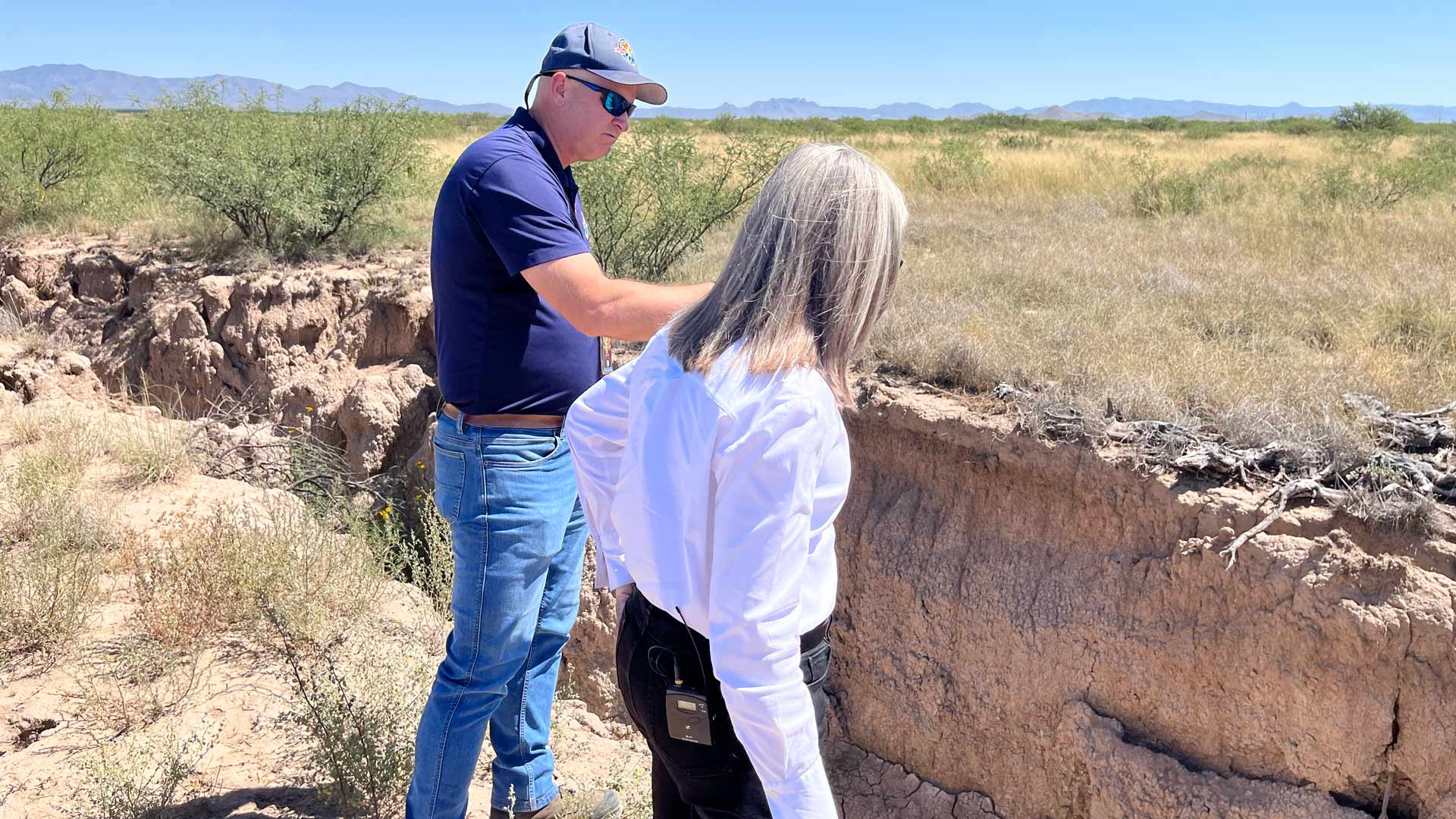 Governor Katie Hobbs and an ADWR staff member look at a fissure near Willcox, AZ. The fissure is caused by dropping water levels in the aquifer. September 5, 2024
Governor Katie Hobbs and an ADWR staff member look at a fissure near Willcox, AZ. The fissure is caused by dropping water levels in the aquifer. September 5, 2024
Brian Conway: This is all caused by groundwater withdrawal. We're pumping out way, way too much groundwater, and it's been going on for more than 50 years. Yeah, they could stop pumping right now, and we'll still get residual subsidence for decades, because it'll take a long time for the groundwater to recover, to fill in those pore spaces that were filled by water and being held open, yeah, are now being held open by air, and so that's why they can crest, yeah, subsurface. But let's take a walk right up here. It's just a short about 100 yards, and we take a really good look at the Earth fissure. The Earth fissures kind of get, I like to say they're the sexy part of subsidence, because, I mean, you can see them. You can't see so north of Willcox, about 12 miles, there's 11 half feet of subsidence that we've measured since 1969 but you can't see it because it's all dropping relative to each other. Yeah. So the ground has sunk 11 feet, 11 and a half feet up there, and then over just northwest of here, where that other substance pole, it's gone down about six and a half feet. Wow. Now, the one up there, it was mentioned in 1969 to now, so it has a much longer time period. So this is what we call a mature Earth fissure. This opened in 2011 but when they start, they start as a hairline crack, because of that differential subsidence when you get tension in the subsurface. And that's what. Causes this crack. And so it's a hairline crack hundreds of feet down, but over time, you get rain that comes off the mountains right here, and it starts to infiltrate that hairline crack, and it starts to erode in the subsurface, and the underlying material finally came in, and then you'll have a large rain, and it'll just rip this open like this.
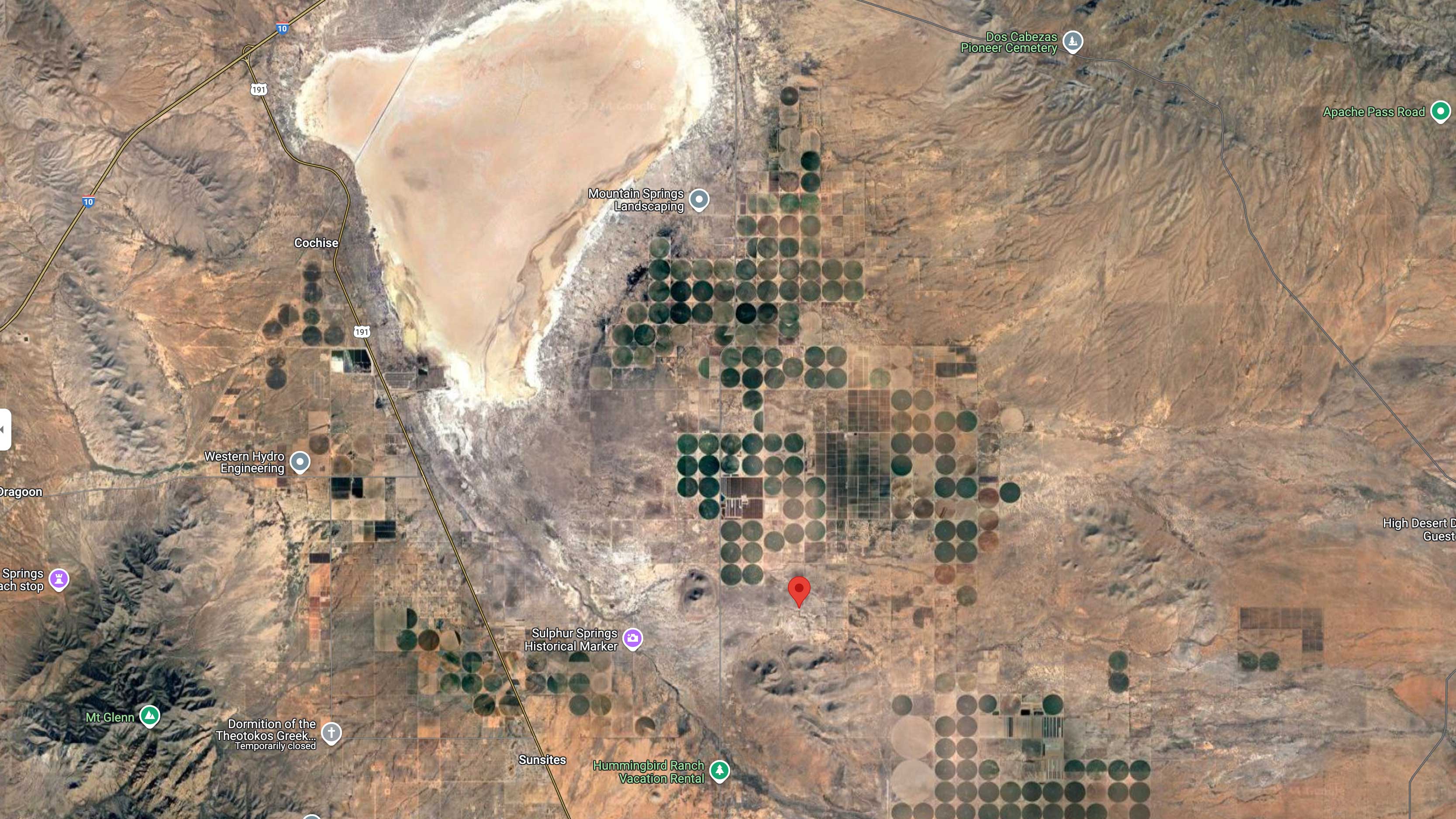 Red spot marks the location of the Earth fissure visited by Governor Hobbs in Cochise County. September 2024
Red spot marks the location of the Earth fissure visited by Governor Hobbs in Cochise County. September 2024
CC: The fissure we were looking at was impressive but it is nestled in a natural area surrounded by dozens and dozens of those pivot irrigated fields…so not really bothering anyone… Conway told us that it is often not the case…
BC: Northwest if you're at Dragoon and Cochise Stronghold Road, where there's a subsidence bowl, there's a couple Earth fissures there. It's, it's busted open. The gas pipeline there? Wild. Yeah, yeah. So this is one of the consequences of, you know, excessive groundwater pumping, subsidence and Earth fissures make it come back up and fill those pore spaces. But once those porous spaces have collapsed, for the most part, there's a there's called inelastic and elastic subsidence. You get seasonal subsidence, where it's going up and down depending on how much is pumping. We see that. We see seasonal subsidence and uplift, but it's still becoming inelastic, where you're taking those pore spaces and they're compressed. So think of like a piggy bank, but instead of coins in there, you have water. So we're crushing that piggy bank. You're basically smashing it. The piggy bank is gone for storing that groundwater. You're losing groundwater storage space
CC: To continue the listening…the Governor next headed to the home of Steve Kisiel…
Steve Kisiel: Welcome to Bella Luna"
CC: As Steve gave the Governor a quick tour of the property he talked about the changes he’s seen…
SK: The well was drilled before we bought and by the previous owner who did not develop the land. It was in good shape. My father was a hydrologist, so I was very aware of water issues in Arizona. He would lecture us all the time anyway. So we got down here, we made sure the water situation was going well. In 1998 things were pretty close to a balance here. 1993 when this well was drilled, they got water, hit water at 230 feet. This was pretty, pretty common for this area. At that time, by 2012 our well went dry. The pump at that point was at about 350 feet, so we dropped almost five feet a year over those 20 years.
CC: He’s a local resident who had backed the Willcox AMA last year. That measure didn’t pass…though a similar one did in the nearby Douglas Basin. The Governor says she understands that the AMA…as it was proposed…was not for everyone…
SK: The frustration was they knew the AMA was not the perfect solution. Yeah, the no on AMA folks were able to paint it as this draconian. You know, the state's going to come over and take over your water. You don't have any control over here.
Governor Hobbs: Yeah, well, I think that's not true, but we're trying to create something that's more flexible.
SK: Absolutely, that's what we've been for all along inside.
[Nat more walking]
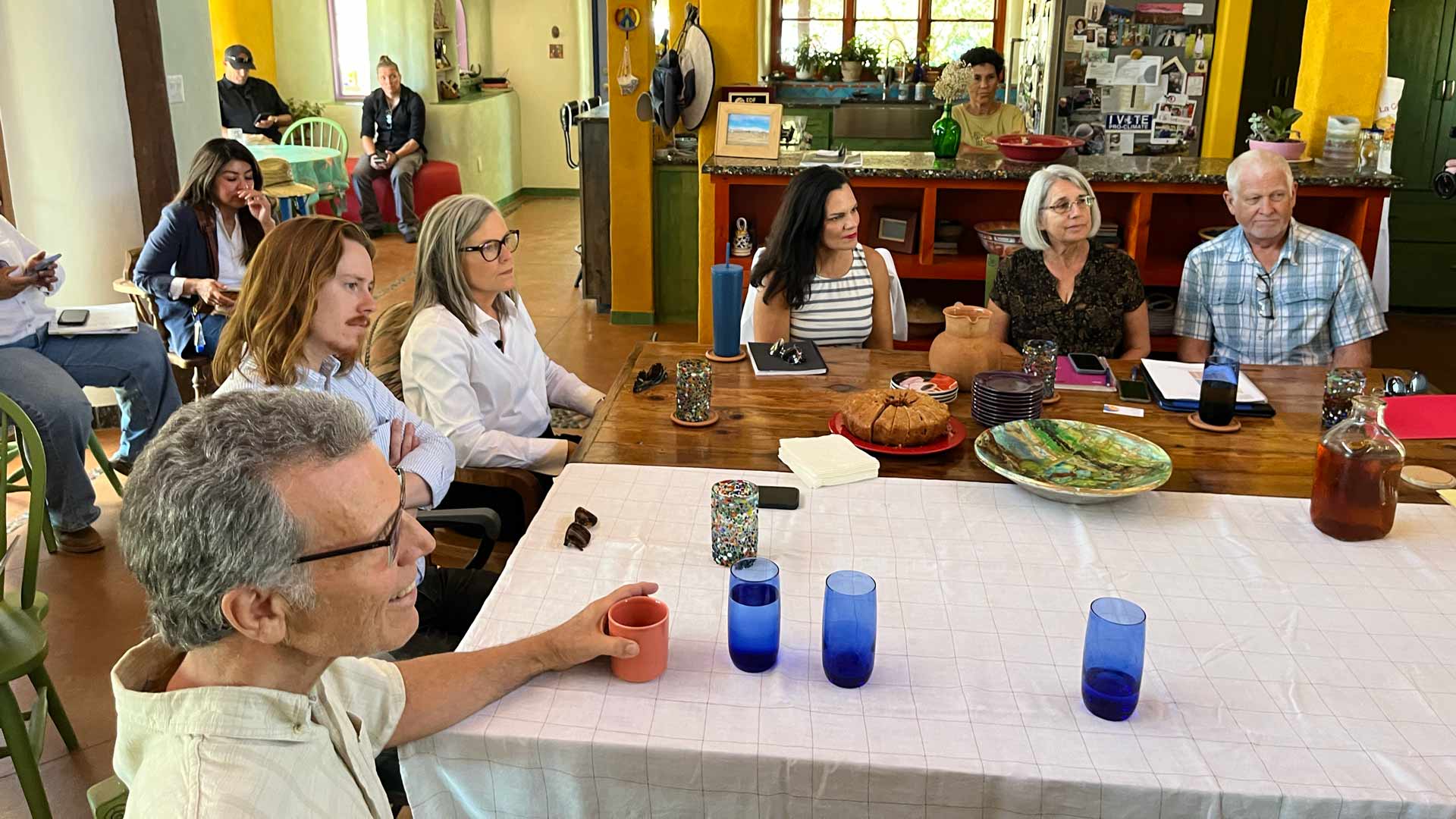 Governor Katie Hobbs and her staff meet with farmers and homeowners near Willcox, AZ to discuss falling water levels in the aquifer. September 5, 2024
Governor Katie Hobbs and her staff meet with farmers and homeowners near Willcox, AZ to discuss falling water levels in the aquifer. September 5, 2024
CC: Inside the house, were more neighbors sitting around a big dining room table waiting to talk to the governor. Cheryl Knott… who also supported the failed AMA …may have summed up the mood best…
Cheryl Knott: The aquifer in the Willcox Basin is our Colorado River.
Retired veteran Vance Williams was also at the table. He told the governor his well went dry when The Riverview Dairy close to his property started sinking deeper wells. Riverview is a massive dairy operation owned by a company in Minnesota and is blamed for many local wells going dry. We reached out to Riverview but they didn’t return our calls or emails.
Vance says after he complained in the local press, Riverview came over and paid for a deeper well on his property…that gave him water for now…
Vance Williams: I'm a disabled vet. Planning on living here. My daughter moved down here. Planned on giving the house over to her. It's all gone, and I can't afford to move. Stay in my house because I don't have rent. I can't afford rent, I can't afford to move, nothing and to have tried many things, have even attempted to start things, to help others, and hit dead balls there too. Did the best I could. We're just waiting at this point for the next time they turn on the faucet and have nothing, it's going to go dry again. There's it's not a question. It's a when. And I think it's going to be a lot sooner than anybody thinks. And it scares me, because it's hard to lift 5-gallon jugs.
Cheryl who is 80… as is her husband… also worried about the future if their well goes dry…
CK: We might not be able to sell our place. And I always wondered, and what do you do?
Sitting on the other side of the table was Sharon Hill. She told the Governor that her children bought their first home but their water and therefore financial future is also cloudy at best due to the dropping wells…
Sharon Hill: They have a 30 year mortgage. Their water will not last 30 to the end of their mortgage. They have children in elementary school. They can't go anywhere. Their jobs are here. Are they going to be able to sell that home?
CC: The group around the table which included Rhona MacMillan and Mark Jorve, who own Zarpara Vineyard, and others also had questions for the governor.
Group: What can you do?
Governor Hobbs: Well, I'm committed to trying to find a path forward for legislation, and the usual suspects have dragged their feet. They dragged their feet during the legislative session to get to the point where it was a last minute push to get this bill through without making changes that we were clear needed to be made. They're doing the same thing during this interim period in terms of getting us language that we can look at. And I understand the urgency after today, I understand it even more I'm hearing from all of you, and I wasn't one of the people sticking my head in the sand saying, Oh, it'll be fine, but I'm prepared to take administrative action if we can't get a legislative path forward. I think the AMA is not necessarily the best solution, but it's the tool we have, which is, again, why we're trying to find the legislative path forward.
CC: Outside the house, the Governor told us there is no quick answer…
Governor Hobbs: Water laws are extremely complicated, and I think we're looking at every administrative tool that we have. The AMA is the biggest one. And you heard some of the reasons that the AMA isn't the best option for this area, which is why the legislative path is really critical, because the tool we're looking to create offers flexibility. It treats different basins differently, gives them the tools that they need to manage the water. It's why we're committed to continuing down that path, and we'll continue to look for other other options. But unfortunately, I think there's not a lot, and legislation's the best option we have, which is why folks that are opposed to changes continue to block that kind of legislation.
CC: Governor, we've heard a couple of times today, even at this table, people saying, My well was fine, until big corporate farms.
Governor Hobbs: Yeah.
CC: We hear this. We heard this during Fondomonte in La Paz County. More wells, Fondomonte, new wells. Riverview, doing new wells. Is there anything the state can do, legislative, executive, legisaltive or otherwise, to say, hey, no more really deep wells. We don't care how much money you have?
Gov. Hobbs: Yeah, and that's what you brought up. Is exactly why an AMA is not going to change the amount of water that they can pump if they're already pumping it now, and so we would need legislation to change that. There's not an executive tool that we have. So we're continuing to look at all the options, and I've got great staff working on it so and it's why we created the Water Policy Council, so that we have a lot of voices at the table to come up with options that work best for everyone.
CC: Sounds like private land at this point, there's nothing we can do private land, Do you do what you want...
Gov. Hobbs: Uh-huh
CC: When we pressed the governor when she would act if the legislature doesn’t she couldn’t give a timetable.
ZZ: So after a day in Cochise County with the Governor can we say what is next?
CC: No we really can’t. The legislature is on the campaign trail right now…ballots go out in less than a month…and they are not scheduled to come back into session until January. That seems to be part of the frustration we heard from the Attorney General at the beginning of this episode since she believes the Governor and the head of the Department of Water Resources…who reports to the Governor…can act now.
ZZ: Tapped is a production of AZPM News. This episode was reported by Christopher Conover. It was edited and mixed by me, Zac Ziegler. Our theme music is by Michael Greenwald. Go to the podcast section of AZPM.org for pictures and more. We'll be back next week as we head south of the border.
Thanks for listening.
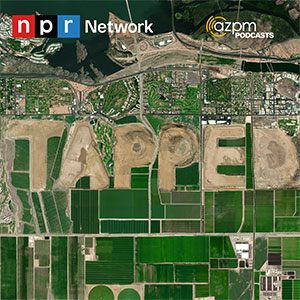





By submitting your comments, you hereby give AZPM the right to post your comments and potentially use them in any other form of media operated by this institution.